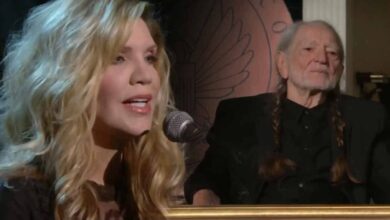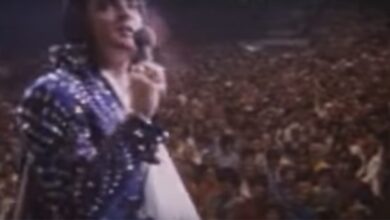This Elvis Song Remains A Romantic Melody That Outshines Today’s Music Even After 50 Years
“Can’t Help Falling in Love” is a song that has etched itself into the fabric of popular music since its debut in 1961. Written by Hugo Peretti, Luigi Creatore, and George David Weiss, the song was first recorded by Elvis Presley for his film *Blue Hawaii*. Its gentle, waltz-like melody combined with Presley’s tender vocal delivery has ensured its place as one of the most iconic love songs ever created.
The song’s composition is characterized by its simplicity and elegance. The waltz rhythm, combined with a soothing and melodic vocal line, creates an atmosphere of romantic nostalgia. The lyrics explore the enchanting and sometimes overwhelming experience of falling deeply in love, conveying both the excitement and the vulnerability that come with such emotions. This universal theme has contributed to the song’s widespread appeal and its continued relevance across generations.
Elvis Presley’s rendition of the song is often cited as one of his most memorable performances. Known for his charismatic presence and distinctive voice, Presley brought a heartfelt sincerity to “Can’t Help Falling in Love.” His interpretation of the song, marked by its gentle phrasing and emotive delivery, captures the essence of the lyrics, making it a favorite among fans and a staple in Presley’s repertoire.
The song’s influence extends far beyond its initial release. In 1993, British reggae band UB40 released a version of “Can’t Help Falling in Love” that achieved significant commercial success. Their reggae-infused interpretation introduced the song to a new audience and demonstrated its versatility across different musical styles. UB40’s version topped charts worldwide and became a defining track for the band, showcasing how a classic can be reimagined while retaining its core appeal.
Other artists have also offered their own unique takes on “Can’t Help Falling in Love.” Andrea Bocelli, for example, has provided a classical interpretation that highlights the song’s timeless quality. Bocelli’s powerful and emotive performance brings a new dimension to the song, emphasizing its romantic and lyrical beauty. Similarly, Haley Reinhart’s cover adds a modern twist with her soulful, jazzy style, appealing to contemporary audiences while paying homage to the original.
Ingrid Michaelson’s version of the song also brings a fresh perspective, infusing it with her signature indie-pop sensibilities. Michaelson’s interpretation is marked by its intimate and introspective quality, offering a more personal take on the classic. Each cover of “Can’t Help Falling in Love” underscores the song’s enduring appeal and its ability to resonate with listeners across different musical genres and cultural contexts.
The song’s versatility and emotional depth have made it a popular choice for significant life events such as weddings and anniversaries. Its ability to capture the profound feelings associated with love ensures that it remains a cherished piece of music for many. The continued popularity of “Can’t Help Falling in Love” is a testament to its timeless quality and its power to connect with people on a deeply emotional level.
Overall, “Can’t Help Falling in Love” stands as a quintessential example of how a well-crafted song can transcend its era and continue to evoke powerful emotions long after its initial release. Its place in the annals of popular music is secured not only by its memorable melody and lyrics but also by the numerous artists who have embraced and reinterpreted it over the years.





